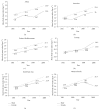Overweight and obesity epidemic in developing countries: a problem with diet, physical activity, or socioeconomic status?
- PMID: 25379554
- PMCID: PMC4212551
- DOI: 10.1155/2014/964236
Overweight and obesity epidemic in developing countries: a problem with diet, physical activity, or socioeconomic status?
Abstract
Obesity is a significant public health concern affecting more than half a billion people worldwide. Obesity rise is not only limited to developed countries, but to developing nations as well. This paper aims to compare the mean body mass index trends in the World Health Organisation- (WHO-) categorised regions since 1980 to 2008 and secondly to appraise how socioeconomic disparities can lead to differences in obesity and physical activity level across developing nations. Taking into account past and current BMI trends, it is anticipated that obesity will continue to take a significant ascent, as observed by the sharp increase from 1999 to 2008. Gender differences in BMI will continue to be as apparent, that is, women showing a higher BMI trend than men. In the coming years, the maximum mean BMI in more developed countries might be exceeded by those in less developed ones. Rather than focusing on obesity at the individual level, the immediate environment of the obese individual to broader socioeconomic contexts should be targeted. Most importantly, incentives at several organisational levels, the media, and educational institutions along with changes in food policies will need to be provided to low-income populations.
Figures


References
-
- World Health Organisation Media Centre; Obesity and Overweight Geneva, Switzerland, 2013.
-
- Centers for Disease Control and Prevention Overweight and obesity 2012. 2013, http://www.cdc.gov/obesity/adult/causes/index.html.
-
- Momteiro C. A., Conde W. L., Popkin B. M. Is obesity replacing or adding to undernutrition? Evidence from different social classes in Brazil. Public Health Nutrition A. 2002;5(1):105–112. - PubMed
MeSH terms
LinkOut - more resources
Full Text Sources
Other Literature Sources
Medical
Miscellaneous

